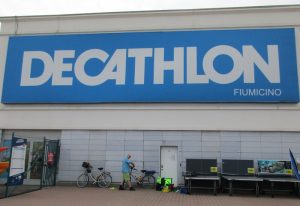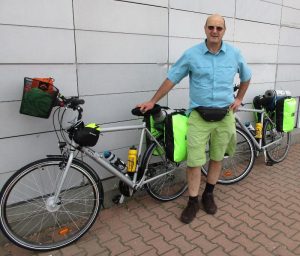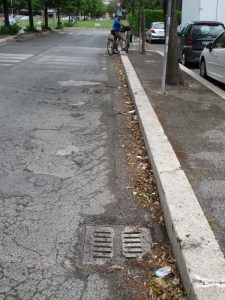Our sleep patterns are still disrupted – Kris and I were up at 3am drinking tea and making notes for the day’s ride. Our plans have changed, we are no longer going South to Bari, but rather cutting across the country to catch the ferry at Ancona (to Split).
We did go back to sleep again for an hour or so, waking up again at 8.30am to a rainy morning. We set off in the light rain to the dire warnings of our hostess about slippery Roman roads after rain. Luckily it didn’t last long and our rain coats were off long before we reached central Rome.
We criss crossed a bit to find the right path, cutting across roads and a ran-shackled park at one point. It was very exciting when we found an off road cycle way alongside Via Christoforo Columbo – this lasted for about 5km and ended when we entered central Rome through an old wall.
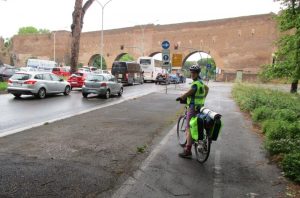
I actually enjoyed the ride through central Rome. The traffic is so slow that we were probably traveling just as fast as the cars, if not faster. We didn’t even try to navigate to the big ticket tourist sights, just passed through.
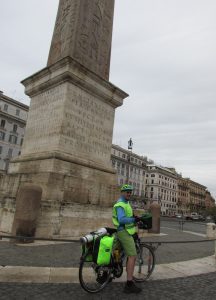
Once we found the Via Prenestina we were able to follow it for about 30km right out of the center. At one point we were overtaken by a young male runner going up a hill. He was training on the road alongside the traffic (probably not enough room on the pavement). It was entertaining when he just ran through every red traffic light without a pause. We only got past him again after a few traffic lights.
Before we knew it, we were riding through green fields, dotted with the odd rundown satellite settlement. The further from the center, the faster the traffic (not so pleasant). The condition of the roads also deteriorated the further we got from the center.
The last stretches of road before Tivoli were really busy, until we got onto our final uphill stretch to the town, which is on a hill. It got so steep we had to get off and push for the last few hundred meters. The entry is through a narrow entrance in a wall that is only really single file for cars. Then it is all cobbled streets and old higgledy piggledy buildings. Very charming. Total travel distance to get here was 53km.
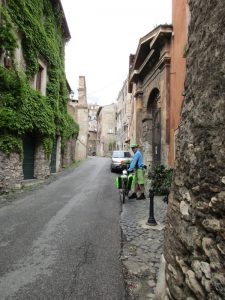 Pushing bike up the hill into the town
Pushing bike up the hill into the town
We found a supermarket and bought some supplies for the night. It was difficult finding our accommodation as the streets are like a rabbit warren – we probably saw most of the town on the way there. Most of the people out and about were mothers walking their children home from school. Cars can get down the streets, but single file and very slowly – so most people get around by walking.
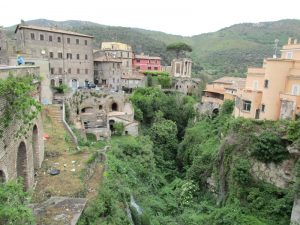
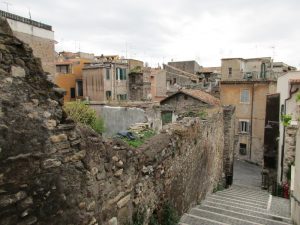
When we got to the apartment we tried ringing the bell and sending a text message to the proprietor, but it was all quiet and shut up. Eventually another occupant of the building came along and called the owner by phone for us. He appeared two minutes later. The apartment is up three flights of stairs, quite spacious and well equiped. It has a kitchen and washing machine (yay, no hand washing!).
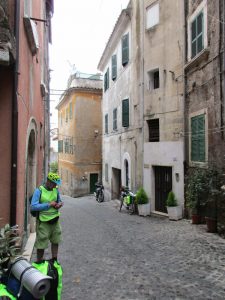 Waiting to get into apartment
Waiting to get into apartment
Our host locked our bicycles up in a lock up storage room on another street. We are the first cycle tourist he has accommodated! Actually, we have not seen any other cycle tourists on route at all – clearly we are ground breakers for this part of Italy!
We went for a bit of a walk around to admire the town, then back to the apartment to drink wine and eat.
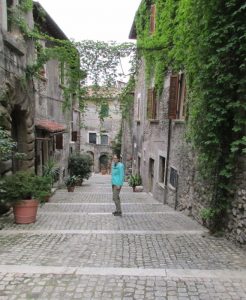
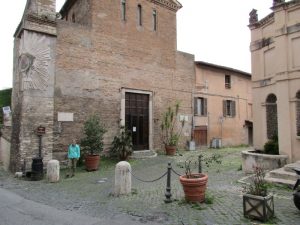
We fell asleep early at around 7pm and woke up again at 5am the next morning!
More thoughts on traffic and Italian drivers
It is fascinating to watch the traffic flow – the drivers don’t seem to follow fixed road rules, but rather take any gaps available on the road. Drivers are expected to take these gaps, so there is no rancor when one driver cuts in front of another. Occasionally there is a snarl up, which they manage to untangle, signaling to each other with honks on the horn
The Roman drivers are used to looking out for all kinds of irregularities at the side of the road – oddly parked cars, pot holes, joggers – ironically it is probably this chaotic state of affairs that keeps us safe, as we were just another obstacle to deftly avoid.
Italian drivers get top marks from us for courtesy to cyclists. They accept that cyclists have a right to be on the road and give them enough room (unlike drivers in NZ and UK). On every occasion where I have been trying to do something tricky, such as cross lanes in traffic, a driver has stopped to let me do so.








